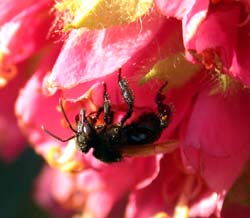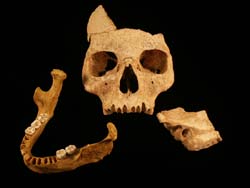Articles and reports from the Life Sciences and chemistry area deal with applied and basic research into modern biology, chemistry and human medicine.
Valuable information can be found on a range of life sciences fields including bacteriology, biochemistry, bionics, bioinformatics, biophysics, biotechnology, genetics, geobotany, human biology, marine biology, microbiology, molecular biology, cellular biology, zoology, bioinorganic chemistry, microchemistry and environmental chemistry.

A team of biologists working in Brazil may have found the clues to resolving the longstanding mystery of why some species of bees, such as honey bees, communicate the location of food with dances in their hives and why other bees simply leave scent trails from the food source to the nest.
In the paper to appear in the October 22nd issue of the Proceedings of the Royal Society, biologists at the University of California, San Diego and the University of São Paulo report that one species of Bra

For apple maggots, the dating scene is simple — flies only mate on a specific host fruit. Using new technology developed at the New York State Agricultural Experiment Station, Cornell University researchers have demonstrated that this fact of fly life has resulted in the emergence of two distinct races of the pest in just 150 years.
In research published in the Online Early Edition of the Proceedings of the National Academy of Sciences Web site Sept. 22, the scientists show that one mechan

Wake Forest University Baptist Medical Center investigators report
A line of monkey stem cells, produced without the use of an embryo, has reproduced for more than two years and still retains the capability of differentiating into a variety of tissue types, a research team reports in the current on-line edition of the Proceedings of the National Academy of Sciences.
Kent Vrana, Ph.D., professor of physiology and pharmacology at Wake Forest University Baptist Medical Center a

A research team co-directed by Erik Trinkaus, professor of anthropology at Washington University in St. Louis, has dated a human jawbone from a Romanian bear hibernation cave to between 34,000 and 36,000 years ago. That makes it the earliest known modern human fossil in Europe.
Other human bones from the same cave — a temporal bone, a facial skeleton and a partial braincase — are still undergoing analysis, but are likely to be the same age. The jawbone was found in February 2002 in Pester

Researchers at the San Francisco VA Medical Center (SFVAMC) have taken the first major step toward isolating adult stem cells from mouse skin, having developed a test that confirms the presence and number of stem cells in a given amount of tissue. Until now, such a technique has only existed for isolating adult stem cells found in blood.
“This assay has opened up a whole new avenue of research,” said Ruby Ghadially, MD, SFVAMC staff physician and UCSF associate professor of dermatology. “If

Protein contains both ’on’ and ’off’ switches
University of North Carolina at Chapel Hill scientists have discovered a unique protein on the surface membrane of plant cells, one that apparently contains both “on” and “off” molecular switches. Apart from its unique structure, the protein may be the first cell surface membrane receptor ever discovered in plants that regulates a key protein complex involved in cell growth and division. Known as the heterotrimeric G pr